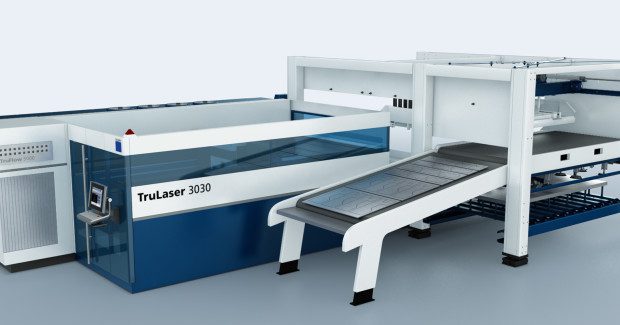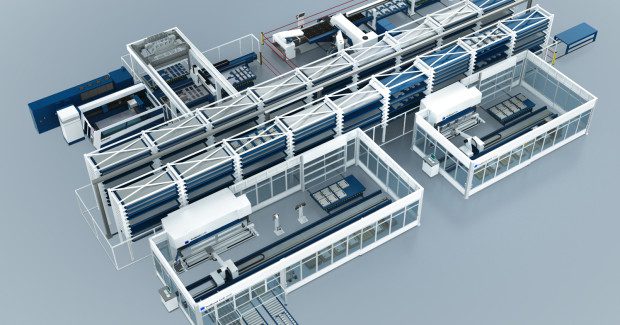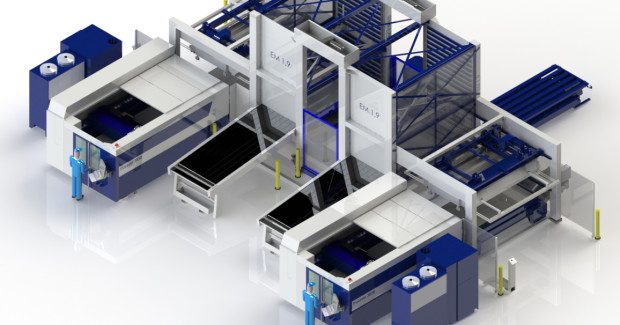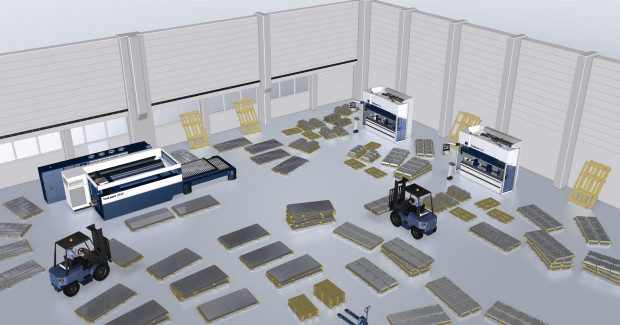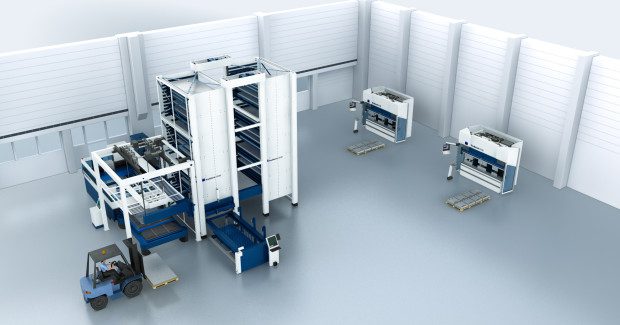The Ins and Outs of Laser Cutting Automation
Advancements in laser cutting productivity are shifting the bottleneck away from cutting the material to handling it. This means automation should match specific needs for different production setups.
Posted: February 25, 2015
Fueled by game-changing advancements in solid-state laser (SSL) technology, automation for laser cutting machines has experienced impressive growth in recent years. Developments in advanced fiber technology and the availability of higher power lasers up to 8 kW continue to close remaining gaps in CO2 and SSL cutting quality and performance. This productivity increase shifts the bottleneck away from cutting the material to handling it. Meanwhile, the industry is faced with increased cost pressure, rising labor costs, and difficulties in finding qualified personnel. Even ergonomic factors play a more important role in today’s manufacturing environment. To be competitive, automation has become a necessity. Here we explore the goal for automating laser cutting machines, the solutions available, and what to consider before you invest.
THE GOAL
The ultimate goal in laser cutting is to keep the laser as active as possible. Money is earned by adding value and that is only achieved when the laser beam is “ON” and productive. Automation helps to increase the productive time of the machine. By maximizing cutting time, fabricators also increase capacity while reducing the hourly cost of laser processing. When the fixed costs (such as the machine investment, reflected in depreciation) can be distributed across a larger number of hours or parts, manufacturers gain the freedom to be more competitive in pricing or to increase their margin.
At the same time, a major goal for laser cutting – and therefore its automation – is increased flexibility. The trend toward smaller batch sizes has made this more challenging, and large and directly linked automated solutions can be inflexible. Making decisions with flexibility in mind is the best way to position a shop for future needs and expansion.
CONCEPTS AND PHILOSOPHIES
Automation concepts for laser cutting vary based on material flow, the process chain, production volume, shift-models, material types, part geometries, part size and thickness, batch sizes, and a variety of other factors. Concepts that address these factors and enable flexible sheet metal production fall into four main categories:
- Loading and unloading of a single machine: The device loads a single machine from a stack of raw material and unloads the finished sheets into a separate stack.
- Small to medium autonomous cells: One or two machines are connected to automated devices for loading, unloading, and potentially sorting. A storage tower unit supplies the machines with raw material and can later be used to store cut sheets. The system functions as an autonomous production cell.
- Large raw material storage units: Machines are connected to a large storage system which supplies each machine with raw material. The material flows only in one direction – from the storage unit, to the machine, to additional processes. Typically, this concept is highly efficient if the storage unit is installed close to a wall, and if the machines are connected to one side of the unit.
- Logistic centers: Machines are connected to a large storage system that handles raw material and semi-finished goods automatically between various processing steps. The storage unit serves as a logistic system and is usually located in the center of the production. Machines are typically connected to both sides, allowing for material flow in various directions, and a buffer function for production purposes is also possible. The key to this structure is overall process control and monitoring. To take full advantage of the increase in processing time and productivity, the system should come complete with software solutions that can control the entire process and the production plan.
Combinations of these arrangements are also possible, and might make financial sense depending on the company structure. With an understanding of what is available, approach the decision while remembering the following facts.
AUTOMATION IS NOT JUST FOR HIGH VOLUME PRODUCTION
In sheet metal fabrication, parts tend to vary in size or shape. It is important to select a solution that will enable very flexible production and guarantee that even small batch sizes or single parts with different geometries or materials can be processed without additional setup time. Running unmanned shifts can also generate additional capacity at a low cost.
Storage options should also be a consideration. While a storage system does not add value directly to the parts, it enables fabricators to stack material vertically, save valuable floor space and efficiently organize inventory. With the right solution, it is possible to reduce or even eliminate forklifts. While a lean approach aims to keep stock levels to a minimum, guaranteeing quick delivery can be a decisive factor for gaining new business. Immediate access to common raw materials enables quick reaction to the demands of the market.
PURCHASING EQUIPMENT IN STAGES
The best automation equipment is modular and allows a fabricator to invest in phases. A laser cutting machine can be purchased and installed in phase one, while automation for loading and unloading can be added in a second phase. Since this automation is typically priced to start at about 30 percent of the machine cost, a relatively low investment can have a big impact. A storage tower can be implemented later from the profits generated by the simple system. It is wise to have the final system in mind and to plan for it from the beginning. This will avoid unnecessary and often costly changes to the shop floor foundation, machines, or placement of the machines within the facility.
Remember that automation devices are connected via standard interfaces and, in many cases, can remain active even if the machine is replaced – typically through two machine generations. Always try to stay flexible for future changes or expansion.
IT IS NOT ALWAYS BEST TO AUTOMATE TO THE MAXIMUM LEVEL
Automation should match specific needs for different production setups. If a company is laser cutting long runs and always with the appropriate number of operators on site, a simple loading device might be the best solution. If the machine is used for prototyping only, no automation may be necessary. In other cases, the benefits of a full loading and unloading system with sorting and a large storage system will far outweigh the investment cost.
The best approach is to review your entire process with a team of specialists, including laser cutting trends and material flow, to identify bottlenecks and future plans. Together, you can determine how to best address the needs of your shop with reliable automated solutions. This will allow you to grow your business and profits in the future.

